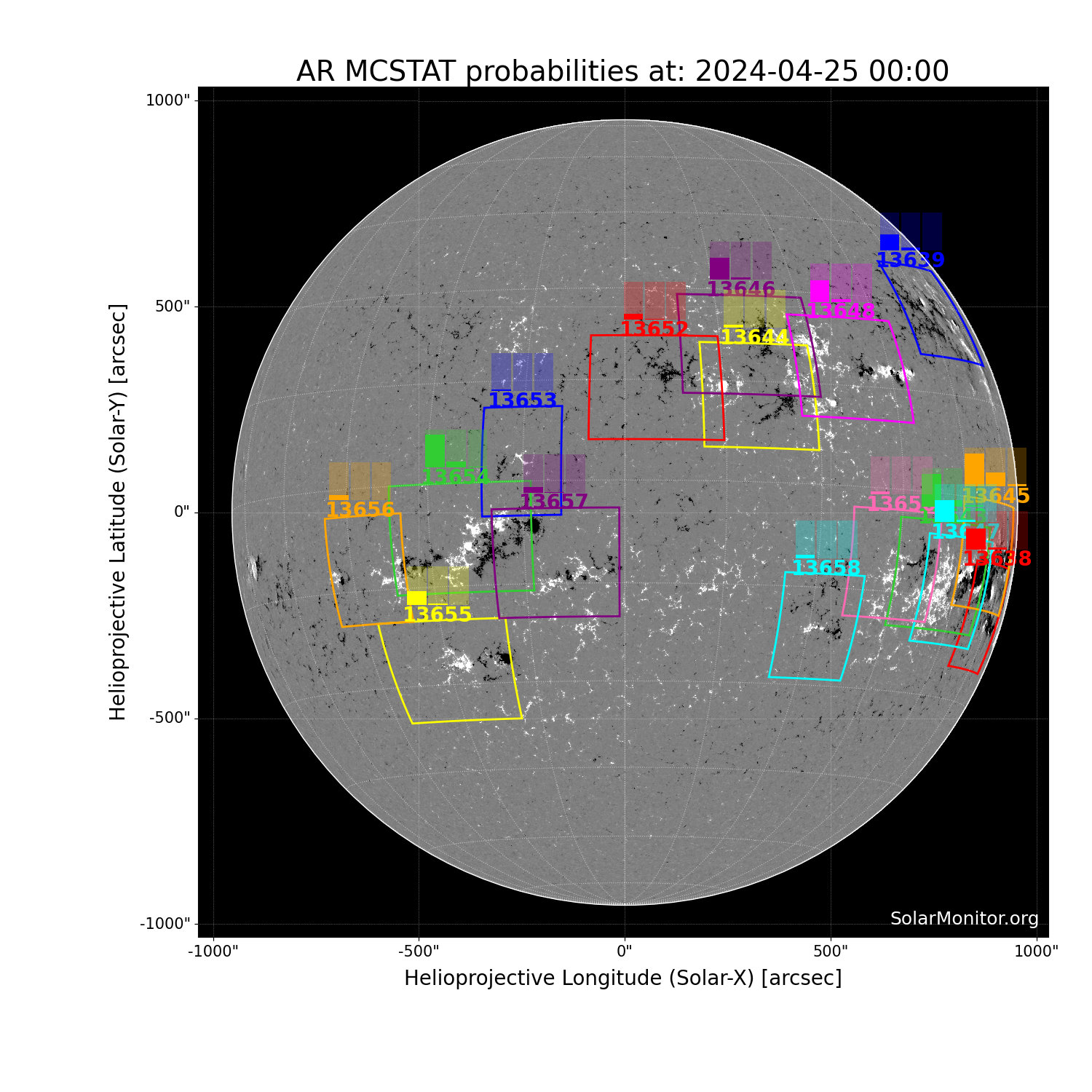
Flare Probabilities [%] (00:00 UTC +24H) ?
| NOAA | C+ | M+ | X+ | Mean ? | |||||
|---|---|---|---|---|---|---|---|---|---|
| MCEVOL ? | MCSTAT ? | MCEVOL | MCSTAT | MCEVOL | MCSTAT | C+ | M+ | X+ | |
| 13638 | 0 | 55 | 0 | 4 | 0 | 0 | 28 | 2 | 0 |
| 13639 | 45 | 42 | 2 | 8 | 0 | 0 | 44 | 5 | 0 |
| 13643 | - | 86 | - | 17 | - | 3 | 86 | 17 | 3 |
| 13644 | 18 | 8 | 0 | 1 | 0 | 0 | 13 | 0 | 0 |
| 13645 | 87 | 86 | 37 | 35 | 9 | 6 | 87 | 36 | 8 |
| 13646 | 49 | 57 | 5 | 6 | 0 | 0 | 53 | 6 | 0 |
| 13647 | 69 | 57 | 14 | 6 | 0 | 0 | 63 | 10 | 0 |
| 13648 | 0 | 57 | 0 | 6 | 0 | 0 | 29 | 3 | 0 |
| 13650 | 78 | 9 | 0 | 0 | 0 | 0 | 43 | 0 | 0 |
| 13652 | 32 | 15 | 2 | 2 | 0 | 0 | 23 | 2 | 0 |
| 13653 | - | 5 | - | 0 | - | 0 | 5 | 0 | 0 |
| 13654 | 72 | 86 | 13 | 17 | 0 | 3 | 79 | 15 | 1 |
| 13655 | 34 | 35 | 0 | 3 | 0 | 0 | 34 | 2 | 0 |
| 13656 | 12 | 14 | 0 | 1 | 0 | 0 | 13 | 1 | 0 |
| 13657 | 4 | 14 | 0 | 1 | 0 | 0 | 9 | 0 | 0 |
| 13658 | - | 9 | - | 0 | - | 0 | 9 | 0 | 0 |
SolarMonitor's flare prediction system's probabilities are calculated using the NOAA Space Weather Predicion Centre's McIntosh classifications. There are two methods, MCSTAT and MCEVOL, that use sunspot-group McIntosh classifications and Poisson statistics to calculate flaring probabilities valid for a 24-hr period starting at 00:00 UTC. The flaring probabilities are calculated using historical data from solar cycles 23 and 24 (1996-2019).
MCSTAT (McIntosh Statistics): Uses the point-in-time McIntosh classification to calculate Poisson flaring probabilities. Details about the method [1] and forecast verification testing [2] can be found in the following papers:
[1] Gallagher, P. T., Moon, Y.-J., Wang, H., Solar Physics, 209, 171, (2002)
[2] Bloomfield et al., 2012, The Astrophysical Journal Letters, 747, L41
[1] McCloskey, A.E., Gallagher, P.T. & Bloomfield, D.S., Solar Physics, 291, 1711, (2016)